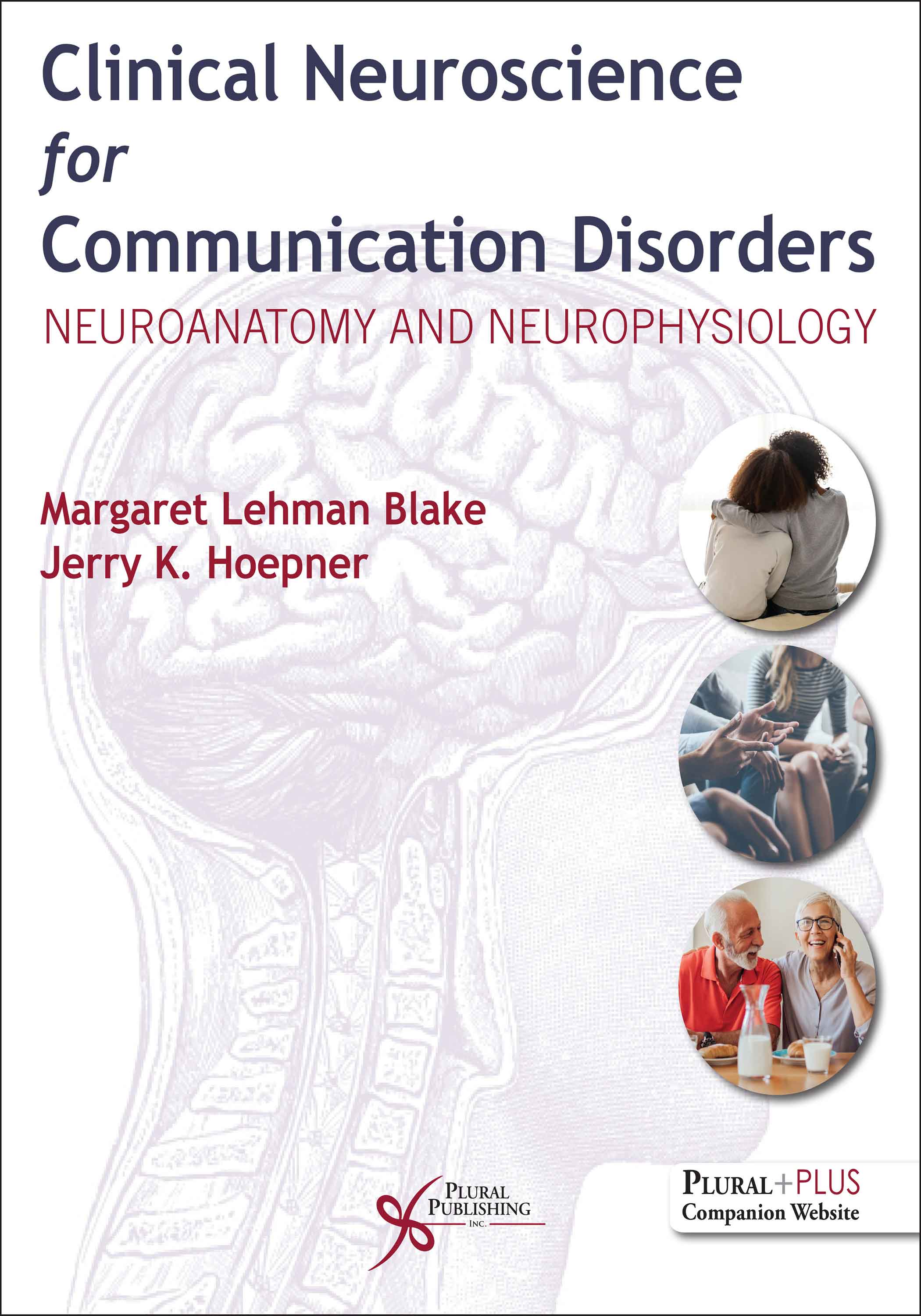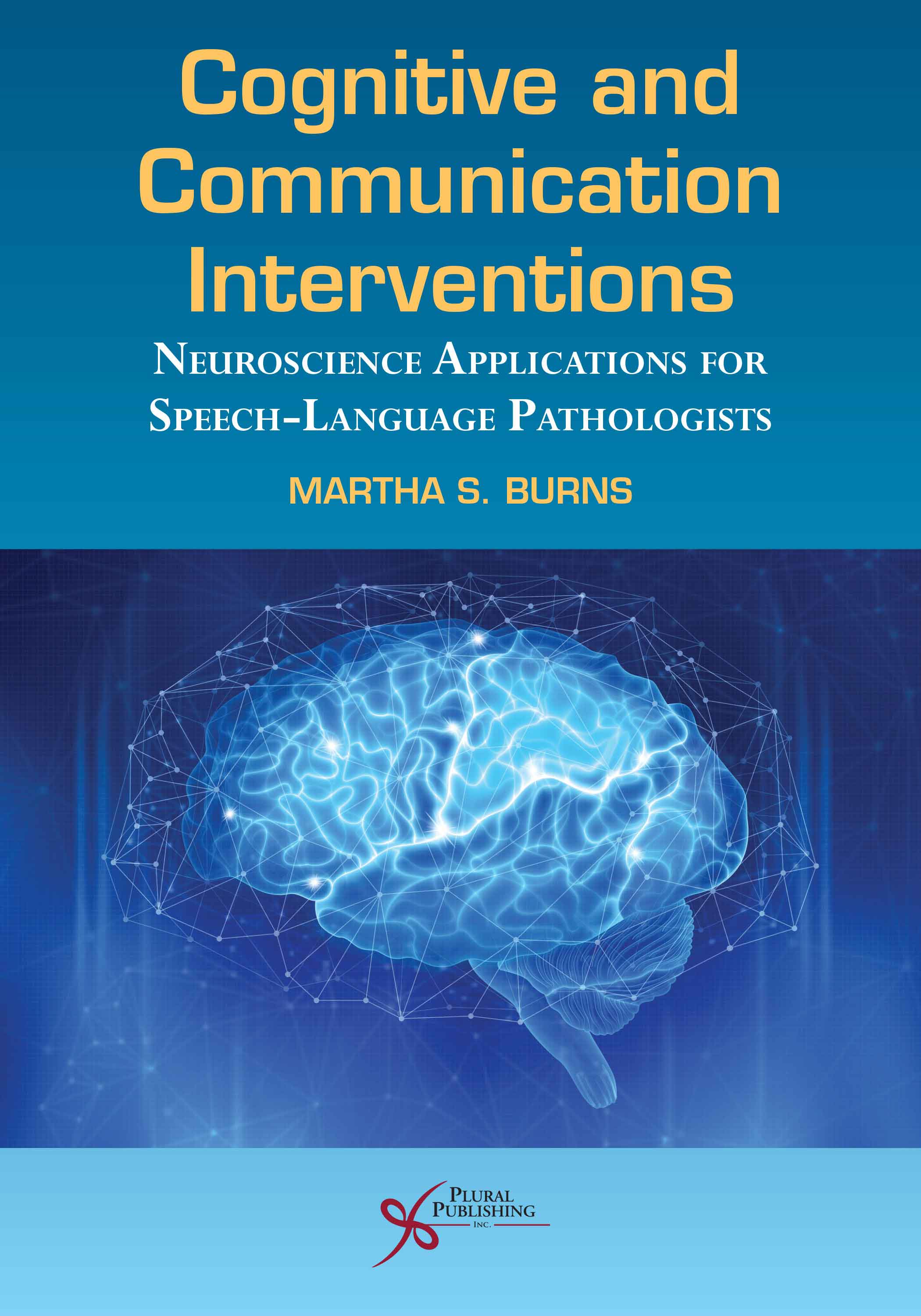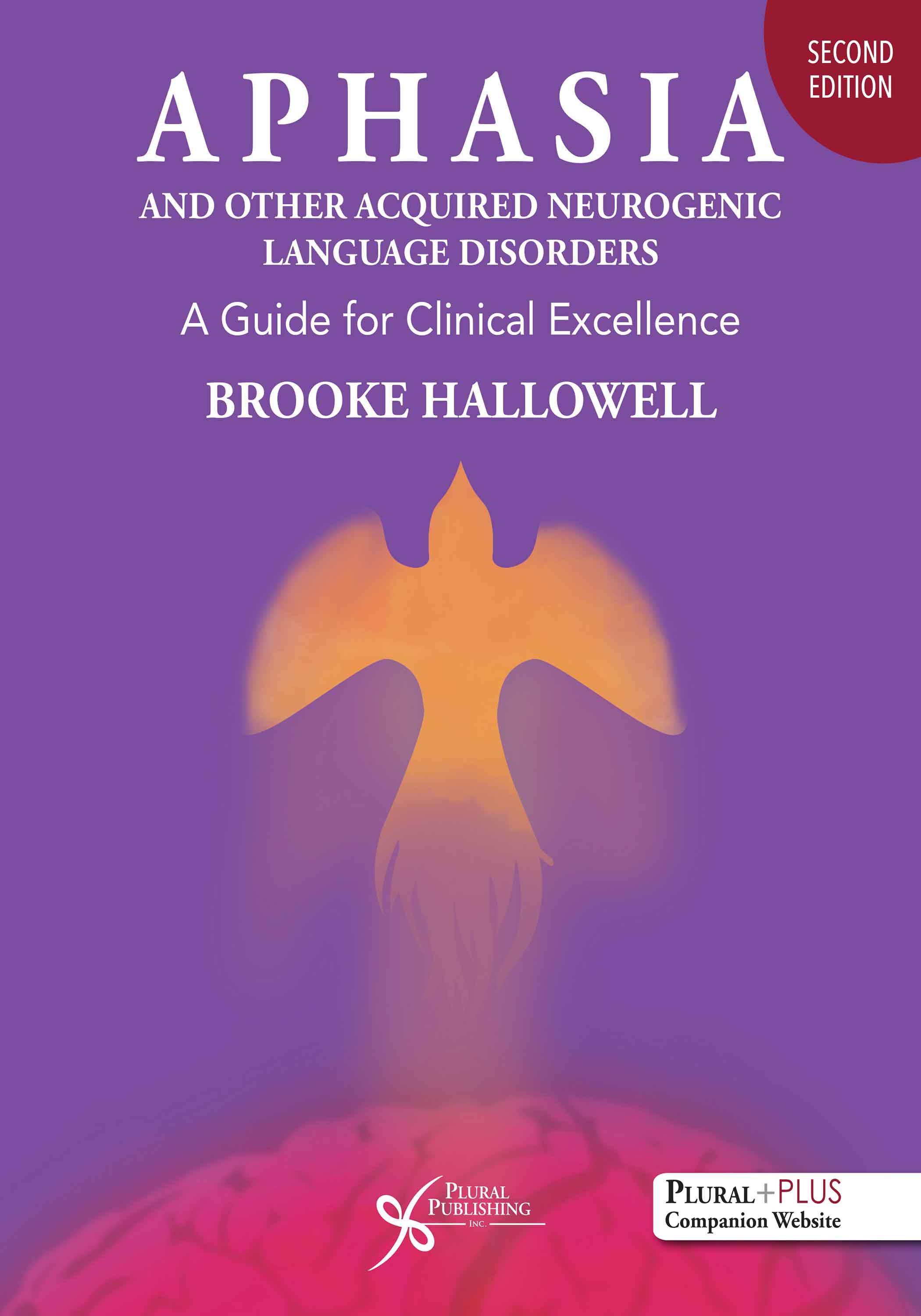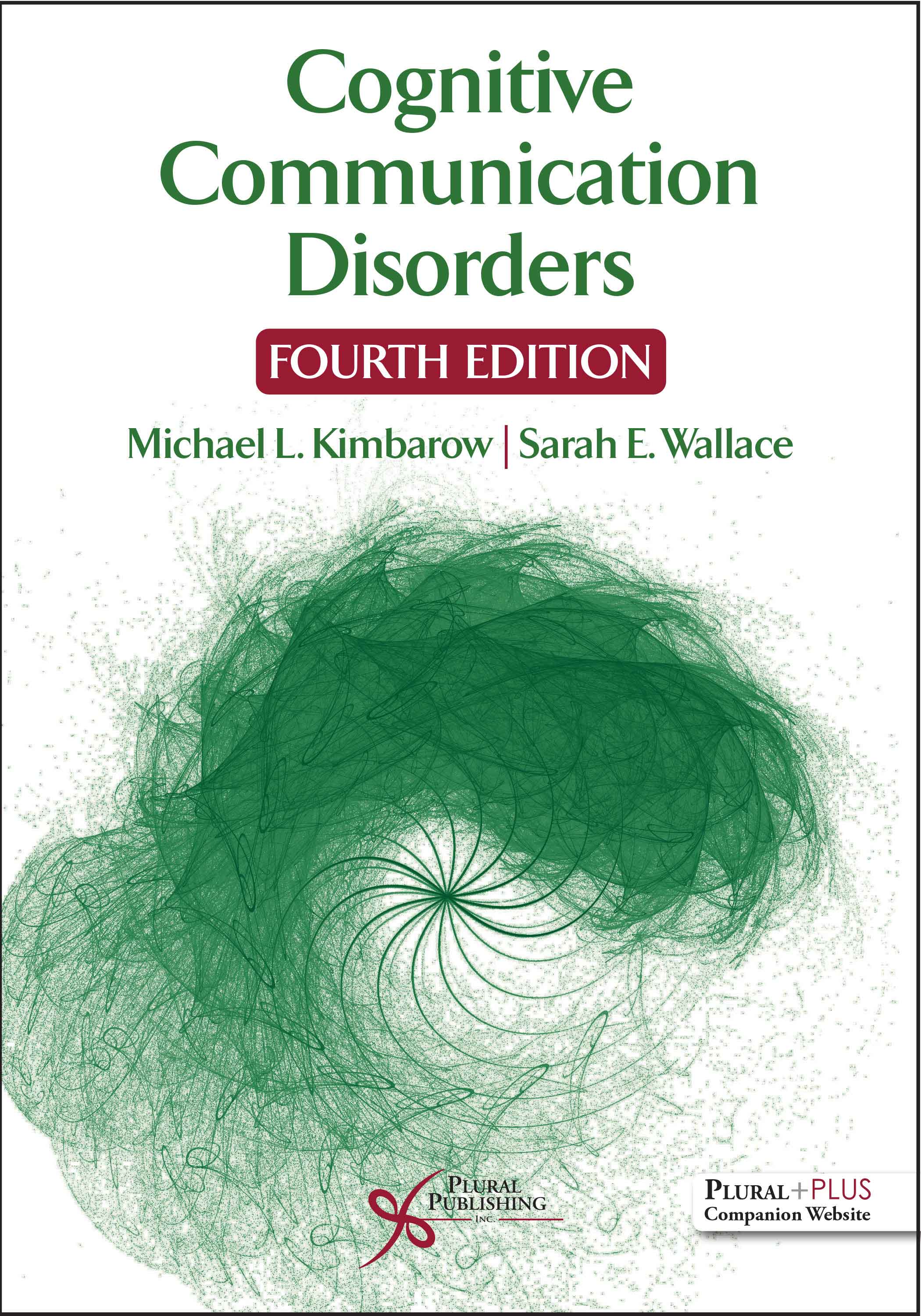
Clinical Neuroscience for Communication Disorders: Neuroanatomy and Neurophysiology.
First Edition
Margaret Lehman Blake, Jerry K. Hoepner
Details: 340 pages, Full Color, Hardcover, 8.5" x 11"
ISBN13: 978-1-63550-365-4
© 2023 | Available
For Instructors
Purchase
A New Edition is Coming in October!
Clinical Neuroscience for Communication Disorders: Neuroanatomy and Neurophysiology offers a comprehensive and easy-to-understand introduction to neuroscience for undergraduates and beginning graduate students in the field of communication disorders.
Packed with features to aid student understanding, this textbook introduces the neurologic underpinnings of systems involved in communication (speech, language, cognition, and hearing) and swallowing, from the nervous system to the anatomy of the head and neck. A highly readable writing style makes abstract and complex material accessible to students and provides just the right amount of information to challenge yet not overwhelm students.
What sets this book apart is the extensive infusion of clinical application. Each chapter begins by tying the content to the everyday clinical applications for speech-language pathologists, audiologists, and related professionals and includes clinical cases to illustrate neural functions. In addition to coverage of the main systems, this text contains chapters devoted to neuroplasticity, communication, and cognition to move beyond basic anatomy to the key principles of contemporary neuroscience and application of the concepts discussed. Additionally, explicit connections are drawn between cranial nerves, the oral mechanism examination, and clinical swallowing assessment. The clinical cases cover a variety of both pediatric and adult scenarios designed to highlight the interconnectedness of neural systems and the complexity of neurologically-based communication disorders. The cases span the breadth of clinical practice—developmental and acquired disorders, pediatric and adult cases, and disorders of speech, language, cognition, and hearing—and are cross-referenced with each of the other chapters for improved understanding.
Key Features
- More than 150 customized illustrations solidify connections between anatomy and physiology
- Clinical cases throughout the text and expanded versions of the cases in a stand-alone chapter illustrate clinical relevance of neuroanatomy and neurophysiology
- Bolded keywords highlight foundational concepts and terminology
- Boxes throughout the text offer an opportunity for applying learning through applications, exercises, glossaries of key terms, and clinical cases
- End-of-chapter summaries provide an overview of the key concepts within the chapter in plain language
- A bulleted list of key concepts concludes each chapter to reinforce learning outcomes
- References and further reading augment student learning
- A PluralPlus companion website with PowerPoint lecture slides for instructors and case studies, lists of recommended reading and websites, and links to related videos for students
Video of the authors discussing Clinical Neuroscience for Communication Disorders
Reviews
"The more I read, Clinical Neuroscience for Communication Disorders: Neuroanatomy and Neurophysiology, the more I became excited about adopting this book for my undergraduate speech pathology and audiology students. Blake and Hoepner meticulously created a neuroanatomy and neurophysiology text that provides just the right of information to challenge yet not overwhelm undergraduate students. In addition, throughout the text the authors provided relevant and appropriate clinical cases to facilitate understanding and to clearly show students why a solid understanding of neuroanatomy and physiology is so important when working with client across the lifespan. ... Periodically, the authors briefly reviewed topics previously discussed in other chapters which helped the reader make connections and integrate information between sections. I also found the Review of Head and Neck Anatomy bonus chapter helpful since many of our undergraduate students take Head and Neck Anatomy during a separate semester. It was nice that this “review” was included within the neuroanatomy text."
—Kelly Knollman-Porter, PhD, CCC-SLP, Associate Professor, Department of Speech Pathology and Audiology, Miami University, Oxford, Ohio
"I have not used a Neurology textbook that so clearly connects content and clinical practice and/or recommendations. When using another textbook, I have to supplement my lectures with activities/readings that help students understand “what does this mean for us as speech-language pathologists” or “how might this information be relevant to our clinical practice”. This is the first Neurology textbook that I have read written for our field that outlines these ideas for students and incorporates them into chapters about particular anatomical regions or concepts."
—Jamie H. Azios, PhD, CCC-SLP, Associate Professor, Department of Speech and Hearing Sciences, Lamar University
Preface: How to Use This Textbook
Acknowledgments
Reviews
Chapter 1. Overview of the Nervous System
Overview
Major Components
Organization of the Nervous System
Organizational Systems
Cytoarchitecture Organization
Organization by Function
Terminology
Nervous System Cells
Neurons
Glial Cells
Structures and Landmarks
Lobes
Frontal Lobes
Parietal Lobes
Temporal Lobes
Occipital Lobes
Subcortical Structures
Basal Ganglia
Thalamus
Cerebellum
Brainstem
Summary
References
Chapter 2. Ventricular System: Cranium, Ventricles, and Meninges
Overview
Cranium, Cranial Vault, and Its Contents
Meningeal Layers
Dura Mater
Arachnoid Layer and Pia Mater
Ventricles
Cerebrospinal Fluid Path and Functions
Communication Through the Ventricular System
Disruptions to the Ventricular and Meningeal System
Hydrocephalus
Meningeal Damage
Summary
Additional Resources
Chapter 3. Neuron Anatomy and Physiology
Overview
Classification of Neurons
Neuronal Communication
Big Picture Overview
Membrane Potentials
Synaptic Transmission
Action Potentials
Myelinated Versus Unmyelinated Axons
Synaptic Transmission
Types of Neurotransmitters
Neurotransmitter Recovery and Degradation
Creating Meaning from Binary Signals
Patterns of Signals
Source of Signals
Region or Location
Conditions That Alter Synaptic Transmission
Neurologic Disorders and Diseases That Affect Synaptic Transmission
Parkinson’s Disease
Multiple Sclerosis
Myasthenia Gravis
Pharmacological Effects on Synaptic Transmission
Blocking Effects
Prolonging Effects
Mimicking Effect
Summary
Reference and Additional Resources
Chapter 4. Neuroembryology
Overview
The Neural Tube
Developmental (Embryologic) Precursors
Sulcus Limitans
Lamina Terminalis (Precursor to the Corpus Callosum)
Vesicles of the Neural Tube (CNS Precursors)
Landmark Timelines
Telencephalon and C-Shaped Development
Disruptions to Development and Consequences
Summary
References and Additional Resources
Chapter 5. Diencephalon
Overview
Diencephalic Structures
Thalamus
Thalamic nuclei
Epithalamus
Subthalamus
Hypothalamus
Pituitary Gland
Damage to the Diencephalon
Summary
Chapter 6. Somatosensory Systems
Overview
Somatosensory System Structures
Sensory Receptors
Mechanoreceptors
Nociceptors
Proprioceptive Sensory Receptors
Thalamic Nuclei
Primary Somatosensory Cortex
Cortical Association Areas
Sensory Pathways
Dorsal Column–Medial Lemniscal Pathway
Spinothalamic Tracts
Spinocerebellar Tracts
Sensory Innervation
Damage to Somatosensory System Components
Spinal Cord Damage
Thalamic Damage
Cortical Damage
Summary
Chapter 7. Visual System
Overview
The Eye
Anterior Structures
Posterior Structures: The Retina
Visual Fields
Visual Pathway
Visual Cortex
Dorsal Pathway
Ventral Pathway
Damage to the Visual System
Visual Field Cuts
Cortical Damage
Summary
Chapter 8. Auditory and Vestibular Systems
Overview
Auditory System
The Cochlea
Converting Sound Waves Into Neural Signals
Auditory Pathway
Frequency and Intensity Coding in the Auditory System
Localization of Sound
Auditory Processing in the Cortex
Hearing Impairment and Damage to the Auditory System
Conductive Hearing Loss
Sensorineural Hearing Loss
Vestibular System
Vestibular Pathways
Summary
Reference
Chapter 9. Chemical Senses: Smell and Taste
Olfaction
Olfaction: The Sense of Smell
Olfactory Pathway
Impairments of Olfaction
Gustation: The Sense of Taste
Gustatory Pathway
Factors Influencing Taste Perception
Impairments of Gustation
Summary
Reference
Chapter 10. Motor Systems
Overview
Motor System Structures
Primary Motor Strip
Premotor and Supplementary Motor Areas
Basal Ganglia
Cerebellum
Motor Pathways
Pyramidal Tracts
Cranial and Spinal Nerves
Corticospinal Tracts
Corticobulbar Tract
Extrapyramidal Tracts
Rubrospinal Tract
Tectospinal Tract
Vestibulospinal Tract
Reticulospinal Tract
Motor Units and Muscle Innervation
Clinical Implications
Motor Cortex
Motor Pathways
Neuromuscular Junction
Basal Ganglia
Cerebellum
Summary
Chapter 11. Cranial Nerves
Overview
General Functions
Cranial Nerve Pathways
Motor Pathways: Corticobulbar Tract
Sensory Pathways
Cranial Nerves III, IV, and VI: Occulomotor, Trochlear, and Abducens.
Muscles of the Eye
Oculomotor Nerve
Trochlear Nerve
Abducens Nerve
Cranial Nerve V: Trigeminal Nerve
Cranial Nerve VII: Facial Nerve
Cranial Nerve IX: Glossopharyngeal
Cranial Nerve X: Vagus Nerve
Pharyngeal Branch of the Vagus
Superior Laryngeal Nerve of the Vagus
Recurrent Laryngeal Nerve of the Vagus
Pharyngeal Plexus
Cranial Nerve XI: Spinal Accessory Nerve
Cranial Nerve XII: Hypoglossal Nerve
Integration of Cranial Nerve Functions
Speech Production
Swallowing
Clinical Implications: Examinations of Speech and Swallowing Mechanisms
Cranial Nerve/Oral Mechanism Examination
Smell and Taste
Vision
Extraocular Movements (CNs III, IV, and VI)
Jaw Movements and Mastication (CN V)
Facial Sensation (CN V)
Muscles of Facial Expression and Oral Preparation (CN VII)
Hearing (CN VIII)
Velar Functions—Motor and Sensory (CNs V, IX, and X)
Laryngeal Functions—Motor and Sensory (CN X)
Spinal Accessory (CN XI)
Lingual Motor Functions (CN XII with a Little Help from CN X)
Lingual Sensation (CNs V and IX)
Oral and Laryngeal Diadochokinetic Rate
Evidence for the OME
Clinical Bedside Swallow Examination and Instrumental Assessment
Summary
Additional Resources
Chapter 12. Limbic System and Reticular Formation
Limbic System Structures and Functions
Homeostasis
Olfaction
Memory
Emotions
Integrating Limbic Information
Reticular Formation and Reticular Activating System
Summary
References and Additional Resources
Chapter 13. Cerebrovascular System
Overview
Blood Supply and Functional Organization
Circle of Willis
Cerebral Blood Supply Distributions
Blood Supply to the Thalamus and Basal Ganglia
Blood Supply to the Cerebellum
Brainstem and Spinal Cord Distributions
Midbrain
Pons
Medulla
Spinal Cord
Blood–Brain Barrier
Disruptions to Blood Supply
Summary
References and Additional Resources
Chapter 14. Communication and Cognition
Overview
Common Developmental Disruptions
Developmental Language Disorders
Autism Spectrum Disorder
Down Syndrome
Fragile X Syndrome
Common Neurologic Insults and Diseases
Traumatic Brain Injury
Degenerative Diseases and Tumors
Communication
Language
Networks
Development
Lesions and Disorders
Pragmatics and Social Cognition
Networks
Development
Lesions and Disorders
Cognition
Executive Functions
Networks
Development
Lesions and Disorders
Memory
Networks
Development
Lesions and Disorders
Attention
Networks
Development
Lesions and Disorders
Summary
References and Additional Resources
Chapter 15. Neuroplasticity
Overview
Neural (Cellular) Plasticity
Behavioral Plasticity
Intensity and Dosage
Factors That Contribute to Participation
Functional Reactivation Versus Functional Reorganization
Summary
References and Additional Resources
Chapter 16. Clinical Cases
Overview
Approach to Solving (Thinking Through) Cases
Section 1: Acquired Cases
Case 16–1. 48-Year-Old Female With Traumatic Brain Injury
Case 16–2: 32-Year-Old Male With Postural Headaches and Mixed Upper/Lower Motor Neuron Signs
Case 16–3. 56-Year-Old Female With Progressive Onset of Dysphagia and Speech Impairments
Case 16–4. 17-Year-Old Female With Traumatic Brain Injury
Case 16–5. 63-Year-Old Male With Aphasia and Right Hemiparesis
Case 16–6. 86-Year-Old Male With Insidious Onset of Cognitive-Communication Changes
Case 16–7. 45-Year-Old Female With Acute Onset of Confusion and Language Impairment
Case 16–8. 62-Year-Old Male With Acute Onset of Lethargy and Impaired Attention
Case 16–9. 52-Year-Old Male With Acute Onset of “Slurred" Speech and “Drunken" Gait
Case 16–10. 70-Year-Old Male With Acute Onset of Dysarthria, Vertigo, Nausea, and Double Vision
Case 16–11. 22-Year-Old With Acute Onset of Weakness and Respiratory Distress
Case 16–12. 62-Year-Old Female With Gradual Onset of Speech and Swallowing Impairments
Case 16–13. 78-Year-Old Female With Gradual Onset of Speech and Gait Disturbances
Case 16–14. 52-Year-Old Female With Declining Cognition, Speech, and Swallowing Function
Case 16–15. 86-Year-Old Female With Memory and Swallowing Difficulties
Case 16–16. 73-Year-Old Male With Right Facial and Tongue Atrophy
Section 2: Pediatric and Developmental Cases
Case 16–17. 5-Year-Old Boy With Shunt Malfunction
Case 16–18. 4-Year-Old Male With Fetal Alcohol Syndrome
Case 16–19. 30-Year-Old Female With Agenesis of the Corpus Callosum
Case 16–20. 11-Year-Old Male With Brainstem Tumor
Case 16–20. 11-Year-Old Female With Traumatic Brain Injury
Case Question Answers
Reference
Appendix. Review of Head and Neck Anatomy
Review
Face
Velum
Tongue
Pharynx
Larynx
Neck
Index
Clinical Neuroscience for Communication Disorders: Neuroanatomy and Neurophysiology comes with access to supplementary student and instructor materials on a PluralPlus companion website.
STUDENTS:
To access the student materials, you must register the access code printed on the inside front cover of your book on the companion website.
INSTRUCTORS:
To access the instructor materials, you must contact Plural Publishing, Inc. to be verified as an instructor and receive your access code.
Email: instructormaterials@pluralpublishing.com
Tel: 866-758-7251 (toll free) or 858-492-1555
*Note for students: If you have purchased this textbook used or have rented it, your access code will not work if it was already redeemed by the original buyer of the book. Plural Publishing does not offer replacement access codes for used or rented textbooks.

Neuroanatomy and Neurophysiology for Speech and Hearing Sciences.
First Edition
J. Anthony Seikel, Kostas Konstantopoulos, David G. Drumright
Details: 385 pages, Full Color, Hardcover, 8.5" x 11"
ISBN13: 978-1-63550-071-4
© 2020 | Available

Neuroimaging in Communication Sciences and Disorders
First Edition
Roger J. Ingham
Details: 243 pages, Full Color, Hardcover, 8.5" x 11"
ISBN13: 978-1-59756-102-0
© 2008 | Available

Cognitive and Communication Interventions: Neuroscience Applications for Speech-Language Pathologists
First Edition
Martha S. Burns
Details: 318 pages, B&W, Softcover, 7" x 10"
ISBN13: 978-1-63550-292-3
© 2021 | Available

Aphasia and Other Acquired Neurogenic Language Disorders: A Guide for Clinical Excellence
Second Edition
Brooke Hallowell
Details: 629 pages, 2-Color with Full-Color Insert, Softcover, 8.5" x 11"
ISBN13: 978-1-63550-159-9
© 2023 | Available

Neuroscience Fundamentals for Communication Sciences and Disorders
Second Edition
Richard D. Andreatta
Details: 802 pages, Full Color, Hardcover, 8.5" x 11"
ISBN13: 978-1-63550-359-3
© 2024 | Available

Acquired Neurogenic Communication Disorders: An Integrated Clinical Approach
First Edition
Jerry K. Hoepner, Margaret Lehman Blake
Details: 362 pages, Full Color, Softcover, 8.5" x 11"
ISBN13: 978-1-63550-425-5
© 2025 | Available

Cognitive Communication Disorders
Fourth Edition
Michael L. Kimbarow, Sarah E. Wallace
Details: 550 pages, B&W, Softcover, 7" x 10"
ISBN13: 978-1-63550-511-5
© 2024 | Available


